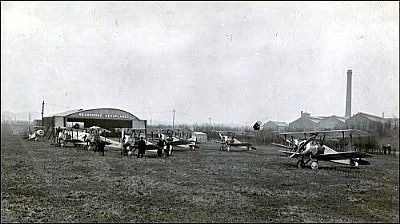DALMUIR AIRFIELD
Strangely, we know that this existed, but not quite where. Having said this, PastMap & Canmore give this location which we have used here. It is a relatively flat area between the Forth and Clyde Canal and the River Clyde, immediately west of the Duntocher Burn.
https://w3w.co/frog.cherry.drum
The area has changed so much over the years because of and since the war. Apparently aircraft construction was within the same premises as that of ships and other such products, but the airfield would have needed to be at a safe distance from cranes and taller buildings. Yet they would have needed to be transferred to the airfield easily so that would not have been that far away.
The UK Airfields & Airports website notes that Wm Beardmore & Co Ltd in Dalmuir on the N bank of the Clyde, about 8nm WNW to NW of Glasgow city centre.... from: 1915 to 1921.
We know that Beardmore & Co Ltd built ships on the Clyde and that is described here : BEARDMORE SHIPYARD, DALMUIR It is surprising to learn that aircraft were also built here.
Here they started churning out military and civilian ships. Their largest was the 27,800 ton battleship HMS Ramillies of 1913. In 1918 they completed the world’s first full flightdeck aircraft carrier, on the hull of an Italian liner they had been building.... The aircraft carrier was christened HMS Argus and would go on to serve in WW2, usually in training and supporting roles but occasionally on the front line when needs must, e.g. here recovering Supermarine Seafire fighter aircraft when covering Operation Torch in 1942.
During WW1, the somewhat restless, expansive energy of Beardmore saw the company move into production of aircraft and aircraft engines under contract. Inevitably, they began to tinker with the designs themselves to improve them, e.g. the Beardmore WBIII, a navalised Sopwith Pup [THREADINBURGH]
The Clydebank Local History Society notes on FB that : The Royal Flying Corp was founded in 1912 and became the RAF in 1918 after the war. The Beardmore Factory in Dalmuir made many planes for WW1 and had an airfield in Dalmuir as well as using one at Renfrew and at Inchinnan where they assembled and flew airships.
None of this clarifies the location of the airfield. Planes being slower then could take off and land on grass and strips relatively shorter than we require today, but some of the planes were large. The Threadinburgh website has an illustration of one with wheel taller than the men standing alongside it.
That same website tells us that :
When the war ended there was inevitably a huge downturn in military orders – both aircraft and ships – and Beardmores started diversifying further. They expanded into production of railway locomotives, cars, taxis, motorbikes, steam lorries and airships. But they still wanted in on a piece of the aviation pie, and continued to tinker with more confidence – but not much more success – in their own designs of aircraft and aero engines.
The Beardmore WB.XXIV WeeBee of 1924 was not a sign of the desired direction of travel. No; they had their sights on something bigger. Much bigger. So big in fact, they had their sights set on producing the largest (by wing span) aircraft (then) in the world. [THREADINBURGH website. See the link below for more].

This photo of eight Sopwith Camel aeroplanes in front of the Beardmore Aeroplanes hangar comes from a William Beardmore & Co Ltd photographic album, 1908-1923. It appears to be looking roughly east with the Beardmore factory premises to the right. Google Images; Glasgow University.
CANMORE/TROVE: https://www.trove.scot/place/331316
THREADINBURGH : The thread about the brief life of the Dalmuir aero industry; when Clyde shipbuilders constructed the largest aircraft in the world. https://threadinburgh.scot/2022/11/06/the-thread-about-the-brief-life-of-the-dalmuir-aero-industry-when-clyde-shipbuilders-constructed-the-largest-aircraft-in-the-world/
UK AIRFIELDS & AIRPORTS website. https://www.ukairfieldguide.net/airfields/Dalmuir

